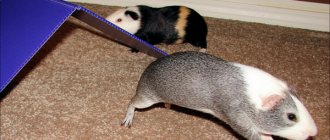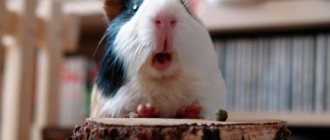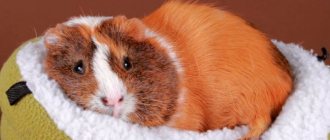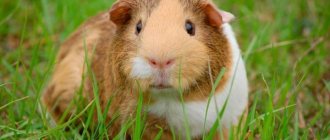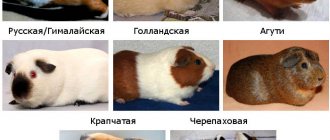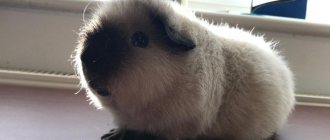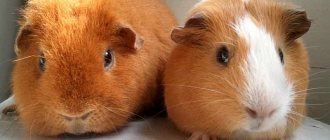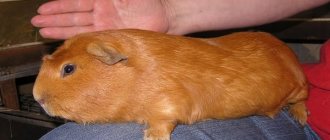Guinea pigs usually behave calmly and evenly, but sometimes their behavior deviates from the usual. They may begin to behave inappropriately and in a frightening manner: jumping, continuously running around the cage, twitching, etc. There is no single answer to why a pet loses self-control and begins to behave so strangely. Such manifestations can be caused by various reasons.
Features of behavior
By nature, guinea pigs are not aggressive creatures. Sometimes they sort things out in rare fights, establish a hierarchy, or simply defend their personal boundaries. However, clashes between animals are quite rare. The only exception is the Kui guinea pigs, who are quite militant not only towards each other, but also towards the whole world.
Most often, the animals are in a joyful and playful mood, willingly making contact with the owner, communicating with relatives.
But sometimes you can notice that the animal looks sleepy or snarls when trying to pet it, hides in a corner and sits with a ruff, and refuses the offered treat. This condition indicates the presence of diseases. The animal must be examined and, if necessary, shown to a veterinarian.
If the guinea pig squeals and twitches while the owner is petting the pet or scratching its tummy, then there is no need to worry. The animal is not sick. This is how he expresses his pleasure. Sometimes satisfied pigs can rumble or grumble, and even lick the owner's hands in response to pleasant actions. An interested animal grunts funny. They make similar sounds when communicating with each other.
Beginning breeders are often frightened by the strange behavior of animals: the pig runs around the cage, jumps, kicks, shakes its head and squeals. Some believe that the animal is sick, while others believe that something is bothering the pig or that it is scared.
This behavior is called popcorning and has a very positive explanation.
Negative signals
A frightened guinea pig will say a dull “Urrrr”, similar to a vibrating alert on a phone, and will tremble slightly. But she indicates irritation with a short sharp squeal - for example, when you carelessly touched her. If the pig is angry, it squeals for a longer time, while clicking its teeth, as if warning: “I’m not in the mood for jokes!”
One of the most impressive sounds a pig makes can be heard at night. This is a very sharp intermittent squeak, similar to the cry of a bird caught in a snare. At the same time, the pig freezes in place, her gaze glazes over. An inexperienced owner may be afraid for his pet. This sound is used by pigs to call their relatives. Little pig babies can express their fear this way.
Since guinea pigs are herd animals, they find it sad to live alone. If your pig makes this noise frequently, try petting your pig more often or give him a buddy in his cage.
If the pig is hungry, you won't miss it. She will stand up and scream shrilly throughout the apartment: “Wee-wee-wee!”, moving her ears. It’s amazing how loud such a small animal can be! Guinea pigs study their owners. They usually remember sounds, such as the sound of a knife hitting a cutting board when preparing a salad or the rustle of a bag from which cabbage is taken out. Subsequently, upon hearing these sounds, the pigs whistle invitingly. They also have a well-developed sense of smell. So you’re unlikely to be able to quietly snack on a cucumber; the alarm will immediately go off!
Popcorning in guinea pigs is a condition of an animal in which its behavior is, at first glance, inappropriate: chaotic running, jumping, convulsions. This looks unusual, but should not cause panic. This playful state is natural and safe. However, its signs are similar to those of some diseases, so it is important to correctly interpret your pet’s behavior.
Popcorning
There is no need to look for reasons why a guinea pig jumps like mad around the cage due to diseases and disorders of the nervous system.
A guinea pig will only popcorn in a state of absolute pleasure, good mood and happiness.
Most often, popcorning in guinea pigs is observed at an early age, when the animal is full of energy and strength, however, an adult pig periodically jumps around the cage, making funny sounds and shaking its head. Often the females begin to jump around the cage after their frolicking cubs, and soon you will notice that the whole family of pigs is jumping merrily, squealing and kicking their hind legs. The name “popcorning” was invented by the Americans. They associated the unusual behavior of the happy animals with corn kernels bouncing in a frying pan while making their favorite popcorn.
conclusions
Why do guinea pigs jump? Often this happens because they are happy with everything and simply enjoy life. This is mainly typical for young people, but older pigs can also run and jump, although not very high. In some cases, the owners themselves teach the animals various tricks, including jumping and running in circles. Perhaps you got an already trained pet.
Did you like the article? Share with friends: [supsystic-social-sharing >
- Related Posts
- What to feed your guinea pig
- Guinea pig's hair is falling out
- Diagnosis, symptoms and treatment of worms in guinea pigs
Bad habits of guinea pigs
Keeping animals in cages without the opportunity to walk and communicate can lead to the development of many bad habits. A confined space causes severe stress in animals. Stress can be determined by the loss of appetite, and by the depressed state, and by the fact that the pig has begun to gnaw on the bars of the cage, feeders, drinking bowls, and even the house. Normally, pigs try to taste all surrounding objects - this is normal.
However, if the animal purposefully and concentratedly destroys objects, this indicates a state of stress.
If a pig is left alone for a long time and not given the opportunity to run and jump freely, this can lead to aggression and withdrawal. All guinea pigs are very social and sociable by nature, but if you don’t pay attention to them, they lose trust in their owner and can start biting, running away and avoiding human contact. Keeping him in a very cramped cage will also provoke the development of the habit of gnawing on the bars of the cage and all surrounding objects, and a reluctance to return to the cage after a walk, which will be shown in fights with the owner and sharp squeaking.
If the animal shows displeasure from the conditions of detention, it is worth changing the pig’s lifestyle, and not think about how to wean the pig from gnawing rods or biting.
- Buy a large cage (for one pig, the optimal cage size is 70 cm by 100 cm),
- Buy a couple for a bored animal (not necessarily an individual of the opposite sex, same-sex pigs get along well with each other),
- Provide a balanced and varied diet,
- Provide a daily opportunity to walk around the room sufficiently,
- Buy a few special toys,
- Pay more attention: scratch, stroke, talk, give treats.
If you don’t have enough free time, it is recommended to purchase a much larger cage or even a two-level one. Divide the feeding and playing areas inside, as well as an area for relaxation and sleeping. Install several mazes, hang smart toys with food inside and several comfortable hammocks. It is important to hang the hammocks as comfortably as possible for the animal, since its legs are very fragile and are not intended for high-altitude jumps. A fall from a high hammock can also result in injury. In such a cage the animal will always find something to do.
Contacting a veterinarian
However, sometimes an animal’s unusual behavior can also mean health problems. If the pet jumps around the cage, lies around, itches itself on everything, and the fur looks dull, begins to fall out and bald patches appear - this indicates the appearance of skin parasites. An animal can become infected with them not only by walking down the street. Often flea or tick larvae get to the animal along with low-quality hay or bedding, as well as poorly washed food. If your pig shows anxiety and loses his appetite, you should consult a doctor. Analysis of the skin scraping will determine both the type of parasite and the degree of infection.
Hums
Rumbling sounds can have a variety of meanings, depending on the position you are currently occupying. If the pig is currently feeling content and happy, then it will emit a guttural rumbling against the background of absolute relaxation and ease. However, if the rumbling sounds have a higher pitch, then the animal is most likely irritated by something. Tension in movements will also indicate this. If you take a closer look at the pet, you can see that it trembles while purring. But abrupt rumbling sounds clearly indicate that your pig is scared or feels uncomfortable.
Diseases
There are several reasons why your guinea pig will jump, jerk, or make other disturbing, erratic movements. Such reasons include the following:
- The appearance of skin itching when various parasites – lice eaters – appear on the animal’s fur. The animal often shakes itself in an attempt to get rid of them. To avoid this, it is necessary to constantly examine the appearance of your pet’s coat. You should examine your skin 1-2 times a week for peeling and redness. Their appearance is a sign of the onset of the disease. Over time, sores may form. If these symptoms occur, be sure to take the pig to a veterinary clinic or call a specialist at home. Only a qualified doctor can provide all the necessary assistance. He will prescribe the necessary medications to properly treat the rodent.
- Helminthiases are diseases caused by worms. The main signs of the disease are the appearance of inclusions in the animal's excrement and a sudden decrease in weight. To determine this, the owner must periodically check the animal’s feces for the presence of worms or their eggs.
- Diseases associated with the dental system. If the pig constantly jumps, shakes its head and also tries to chew through the bars, this indicates problems with its teeth. To help your pet avoid the formation of stones and plaque on the incisors, it should be shown to a veterinarian at the clinic. He will be able to tell you what the problem is and correct the abnormal growth of the roots of the teeth.
What can it be confused with?
The pet's body movements during popcorning can be confused with the manifestation of fear, which was caused by:
- Loud noise;
- sudden movements;
- sudden touch by the owner;
- cleaning the cage (some animals don’t like this).
Popcorning is a relatively safe process that stops on its own and does not subsequently affect the pet’s behavior. And frightened, chaotic movements require immediate elimination of the cause that caused them, because at this moment the animal is experiencing severe stress.
In addition to fear, your pet's jumping can be caused by:
- Blood-sucking parasites - ticks, fleas. The animal will itch and its fur will fall out. Infection usually occurs through hay.
- Worms. Signs of this disease are a decrease in the pet’s weight, the presence of parasites or their eggs in the feces.
- Dental disease. If your pig is desperately trying to chew through the bars of the cage and is constantly running around, this may indicate a dental problem.
The energetic jumping and squeaking caused by popcorning is a normal manifestation of your pet's joy and high spirits. To rule out the possibility of illness, you should monitor your mumps during an attack. If there are no dangerous symptoms, then there is no reason to worry.
Sometimes guinea pigs can surprise even experienced breeders, let alone beginners who are stunned, trying to figure out why their pet is twitching and shaking its head. When seeing such a sight for the first time, pig owners are horrified and begin to suspect various terrible diseases. What could be the reasons for their instant activity?
Natural reaction
Sometimes the reason why your piggy is jumping can be due to its natural behavior. Most often this occurs in young individuals. The animals show their cheerful mood in this way, frolicking and rushing around the entire cage. Some rodents can rock the cage, making whistling sounds. If, in addition to the young pig, there are older individuals, then they begin to repeat after the young pig. The unusual behavior may last about 7-15 minutes, after which the pet either begins to drink and eat, or rests. This phenomenon among healthy pigs is called “popcorning.” The way they jump can be compared to the exploding kernels of corn when they are fried.
Basic moments
Crazy jumps around the cage are not a cause for concern, but a reason for joy. The galloping animal is not sick, but happy and splashes out its accumulated energy.
Popcorning is crazy jumps and somersaults
Strange actions performed by a pet are called popcorning. The choice of name was due to the amazing similarity of rodents to corn kernels bouncing in the microwave while popcorn is being made.
Funny behavior is common to all ages, but is more common in young individuals.
Pig shows last about 5 minutes and include:
- jumping and turning over in the air;
- dancing using the fifth point;
- squeals, squeaks and other crazy sounds of delight;
- falls and febrile convulsions;
- cutting circles at the incredible speed of a racing car.
If the pig runs around like crazy and successfully involves other cage inhabitants in its madness, then release the animals to freedom. After expanding the territory, the rodents will quickly calm down and fall into deep sleep, replenishing the energy expended.
After a burst of energy comes a sound sleep
Return to the cage
If your guinea pig is jumping around the cage, this may be a reaction to the animal returning to it after a walk. Familiar smells and surroundings bring the animal into joyful excitement. This reaction is normal, so the owner should not worry. It happens that a pet constantly jumps off his hands, and the owner approves of this. Under no circumstances should you allow your pig to behave this way. If she actively jumps from the owner's hands into the cage and back, she may injure herself on the bars or injure her paws. Therefore, it is better to wean the animal from a bad habit.
The pet must be held tightly when inserted into the house, but not released. The pig will have to be held until it calms down. Then the rodent must be quietly placed on the floor. Do not put pressure on the animal's back to avoid damaging the spine. If the pig still breaks out of your hands, you will have to repeat your actions a couple of times.
First: catch me if you can
Don’t take it to heart when you approach a guinea pig with the intention of picking it up, and it just blows away from you with all its agility! This is completely normal, you still have to gain your pet's trust. In the wild, our funny piglets are a tasty prey for many predators, so if you can run fast, then you are safe. Pigs simply cannot curb their instincts when someone invades their space. Finally, remember your own reaction to unexpected sharp and loud sounds. You'll probably jump when a car creeps up behind you and honks its horn? Then don't be offended by your pig!
Why does my guinea pig jump around the cage and twitch?
Guinea pigs usually behave calmly and evenly, but sometimes their behavior deviates from the usual. They may begin to behave inappropriately and in a frightening manner: jumping, continuously running around the cage, twitching, etc. There is no single answer to why a pet loses self-control and begins to behave so strangely. Such manifestations can be caused by various reasons.
Diseases
The reason that a guinea pig jumps and twitches may be endoparasites (lice eaters, ticks, fleas, etc.) that have gotten onto the pet’s fur coat or the surface of the pet’s body. Parasitic insects provoke skin itching, so restless behavior is usually accompanied by scratching and shaking the fur.
Regular skin examinations and checking the condition of your pet's coat will help prevent the development of diseases caused by endoparasites. It is especially necessary to carry out examinations of long-haired pigs. Thorough inspections should be carried out at least once a week.
Already at the initial stage of the disease, the pet’s skin turns red and peels, which later transforms into wounds and damage. If you notice these symptoms, you should immediately show your pet to a veterinarian. Only a doctor can specifically identify the causative agent of the disease, select the necessary medications and prescribe appropriate therapy.
Natural reaction
If an animal twitches and jumps, this is not always an alarming signal. For most rodents, this behavior symbolizes joy. Especially often, such attacks of unbridled fun, when the whole cage is shaking from the “raging” little pet, happen in young animals.
Moreover, they infect all their neighbors with a violent attitude, regardless of their age. All young and adult pigs join in the fun. Therefore, the more individuals live in one cage, the more stormy and noisy the “party” will be. In the process, the guinea pig jumps around the cage, runs, whistles, shakes its head and even rocks its home.
This phenomenon is called “popcorning” (derived from popcorn). The name is apt - the static corn balls begin to bounce and flop around as they heat up while popping popcorn.
There is no need to worry about this behavior of pets, you just need to wait it out. In 5–10 minutes the “holiday” will end, the rodents will rest, eat and drink - in a word, gain strength.
Return to the cage
Another common reason for guinea pigs to jump is when returning to their home. Sometimes they begin to jump for joy even before they get into their home cage, that is, in the hands of the owner. It happens that the pig jumps from the owner's arms. Some owners not only do not interfere with this, but even encourage the impulses of the “sports” pet. But with such jumps, a pet can easily harm itself, get injured or bruised.
To prevent this, it is important to wean your pet from such tricks. To do this, you need to firmly but carefully grab the animal with your hands and place it in such a “trap” inside the cage. The pig should be kept at a height of several centimeters from the bottom. It is important not to unclench your hands until the pet calms down. Then the animal is placed on the floor of the cage, but is not completely released until it stops twitching and struggling. When the pig finally calms down, you can give her freedom. If necessary, the lesson is repeated.
Other reasons
Among other reasons why a pig begins to behave strangely, it is worth noting a lack of exercise. If your pet has no place to stretch his legs and run around to his heart's content, he will begin to jump in place and run at jet speed around the cage. To prevent the lack of physical activity from negatively affecting the health of the animal and the general condition of its body, it is worth at least from time to time letting it out of the cage for a walk - jogging across a wide area will benefit the pet.
If running around is interspersed with breaks, during which the animal gnaws at the cage, this is a reason for concern and contact a doctor. Your pet probably has dental problems.
If restless behavior is combined with lethargy (for example, the pet lies on its side and twitches, etc.), there is a high probability that the animal has ectoparasites (that is, internal ones). If such manifestations occur, you should immediately show the rodent to a veterinarian. Otherwise, the pet will die.
Why does my guinea pig jump and run around the cage? — Popcorning in guinea pigs
IMPORTANT: Don't be afraid if your pig suddenly starts eating popcorn.
When a guinea pig is absolutely happy and satisfied, it begins to run and shake its head - in this way the pig shares its joy with its owner. This phenomenon is called popcorning. The name was invented by the Americans when they noticed a surprising similarity between the cheerful jumps of a guinea pig and the process of making popcorn, when corn kernels burst in a frying pan and fly up. In other words, popcorning is a phenomenon in which a pig begins to behave like popcorn. At first this sight may seem strange, but over time you will get used to it and will watch your pet with a smile.
Reasons for crazy racing
Your guinea pig may suddenly start running around the cage due to the following reasons:
- Return to the cage. When you pick up a pig, it is stressful for him: a different environment, new smells, so when he returns to the cage, the pig feels comfortable and safe. These feelings give rise to the desire to run around tirelessly.
- Natural reaction. In most cases, such jumps are explained by a natural manifestation of joy. This is especially common in young pigs who are still full of strength and energy, as well as in groups.
IMPORTANT: Popcorning is contagious! The fun of one pig can easily make other pigs popcorn, even the adult generation.
- Diseases. If the previous reasons could cause joy and tenderness in the owner, then this reason should make him think and carefully study the pet’s behavior during the next races. Various exoparasites can disturb your pet, and dental problems are also possible.
In what cases is medical attention needed if a guinea pig is jumping and twitching?
Please note that guinea pigs are susceptible to a number of diseases with symptoms similar to popcorn. In this case, the pet’s jumping looks more like anxiety than fun: the pig seems to be trying to dodge something.
“Unhealthy” popcorn may indicate the following diseases:
- Skin parasites. These include blood-sucking parasites (ticks, fleas), as well as lice-eaters. They get on your pet's fur and cause itchy skin. When skin parasites appear, the guinea pig's jumps are accompanied by frequent scratching and biting of itself, it tries to rub itself on everything, and also shakes itself frequently to reduce the pain. The pig's fur loses its former shine and begins to fall out, forming bald patches on the body. In the early stages, redness and scaly skin begins to appear on the guinea pig's skin. Regular inspection of your pet's coat can be a preventative measure.
IMPORTANT: You can become infected with skin parasites not only by picking them up on the street while walking, but also at home (poor quality hay or bedding, poorly washed food).
- Worm infestations. This disease is accompanied by a sharp loss of weight and the appearance of inclusions in the pet’s feces. When cleaning the cage, always pay attention to your guinea pig's feces: if they are infested with intestinal parasites, they may contain eggs or adults. For treatment, you can use Shustrik paste, which can be purchased at any veterinary pharmacy.
- Dental diseases. If your pig is running around the cage and trying to chew through the bars, then most likely he has problems with his incisors. In this way, she tries to grind off the excess length of the incisors, which causes discomfort. Also, by its behavior, mumps can indicate improper growth of root teeth and the formation of tartar.
IMPORTANT: If you do not consult a doctor in time about a problem with your incisors, your pig will not be able to eat. The incisors can become so long that they simply block food from entering the mouth.
- Lack of movement. If the size of the cage does not allow the guinea pig to run around enough, it begins to run and jump in place. It is worth letting your pig out for a walk at least occasionally so that the lack of physical activity does not have a negative impact on its health.
Help, the barnacle is constantly twitching.
Help, the barnacle is constantly twitching. ¶
My pig constantly twitches and jumps as if she had been stung, sometimes she falls over on her side. What with her?
Help, the barnacle is constantly twitching. ¶
Most likely it's popcorning. Read about it on the forum.
Help, the barnacle is constantly twitching. ¶
It would be nice to describe in more detail what it means to twitch, with one paw, with all of them, with the belly, with the head, and how it breathes, especially when it falls over on its side. Maybe there are some sounds.
Help, the barnacle is constantly twitching. ¶
I haven’t seen a pig fall on its side while popcorning. He just bucks and gallops like an unbroken mustang on the prairie. Rolling onto your side is a strange symptom, please describe it in more detail.
Help, the barnacle is constantly twitching. ¶
As soon as I let her out of the cage, he starts jumping and galloping like crazy and collapses on his side in his arms. And in the cage he only jumps sometimes. Although he's been quieter lately.
Help, the barnacle is constantly twitching. ¶
It seems to me that this is simply due to the young age of the pig and, as they wrote, popcorning. And not the least important role is played by the fact that, apparently, the pig is not very tame yet. When she gets used to you, everything will become much easier.
Help, the barnacle is constantly twitching. ¶
Yes, if he falls over on his side in his arms, then it’s not scary, most likely popcorn. At first I thought that the pig on the floor was falling on its side! laughter
Help, the barnacle is constantly twitching. ¶
From: Zyazya - March 17, 2005 3:16
Nauria, Zyazi had the same thing. We went to the veterinarian and the doctor said: For 2 weeks, feed Zyazya from a syringe 2 times a day with a chamomile solution.
Now everything is fine again. It’s just “To increase the internal flora”, that’s why the pig was twitching.
Help, the barnacle is constantly twitching. ¶
I'm an amateur, but... Mine was twitching and squealing when the fleas bit him. My son brought home an incomprehensible creature and said it was a guinea pig! I was afraid to even pick it up! And he's still twitching! But mostly only when they were released. And then we looked carefully at the fur, and it looked like white worms there, standing vertically. It was then that the veterinarian explained to us that pigs have special fleas. We took them out and the pig began to twitch 10 times less and stopped falling over on its side.
https://nalugah.ru/zhivotnovodstvo/morskie-svinki/pochemu-morskaya-svinka-prygaet-i-gryzyot-kletku-popkorning-u-svinok.html https://priut-stolbiwe.ru/1343-pochemu-morskie -svinki-prygayut/ https://forum.svinki.ru/forum/forum-16/topic/topic-5823/
